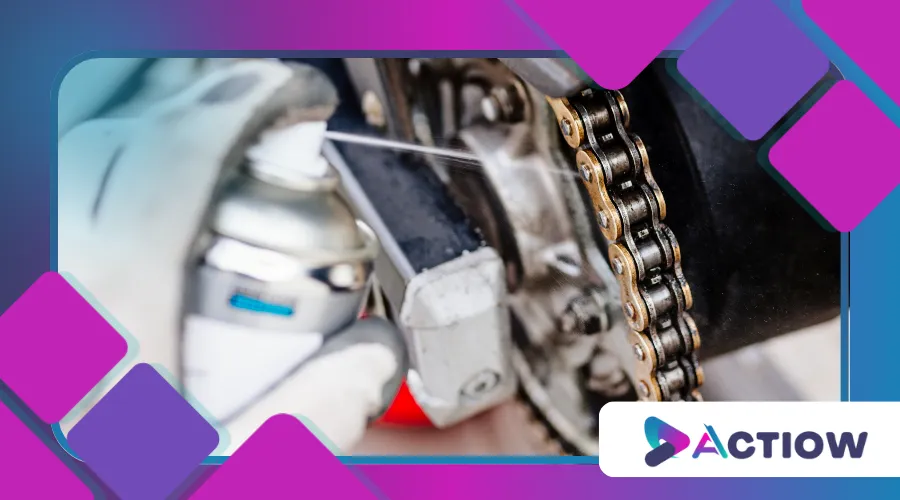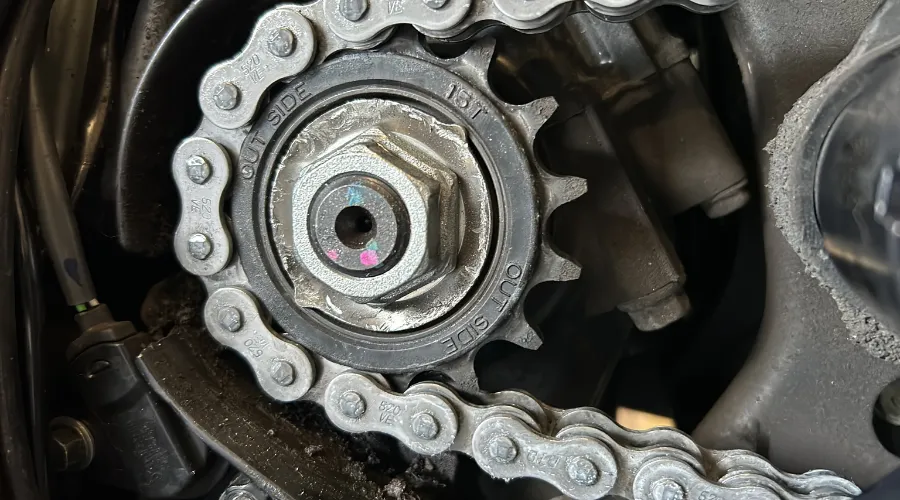Motorcycle Chain Maintenance in the Age of High-Torque Electric Bikes

Anúncios
Motorcycle chain maintenance has never been more critical as electric bikes redefine performance with blistering torque and instant power delivery.
The rise of high-torque electric motorcycles, like the Zero SR/F or Energica Ego, introduces unique challenges to chain care that riders must address to ensure longevity, safety, and peak performance.
Unlike traditional gas-powered bikes, electric motorcycles deliver near-instantaneous torque, placing unprecedented stress on drivetrain components.
Anúncios
This article dives into why chain maintenance matters more than ever, offering practical, cutting-edge strategies to keep your ride smooth and reliable in this electrified era.
The Evolution of Motorcycle Chains in Electric Bikes
Electric motorcycles are rewriting the rules of two-wheeled performance.
With torque figures often exceeding 140 lb-ft—compared to the 80-100 lb-ft of many gas-powered superbikes—the chain endures intense forces.
A 2023 study by the Motorcycle Industry Council noted that electric bike adoption grew 28% from 2020 to 2022, signaling a shift that demands updated maintenance practices.
The chain, a critical link between motor and wheel, faces rapid wear if neglected, especially under the relentless power of electric drivetrains.
Riders must adapt to this new reality, as improper care can slash chain life by up to 40%.
Consider the analogy of a chain as the spine of your motorcycle.
Just as a spine supports and flexes under pressure, the chain absorbs and transfers immense forces.
Neglect it, and the entire system falters—jerky rides, reduced efficiency, or even catastrophic failure.
Modern chains, often O-ring or X-ring designs, are engineered for durability, but electric bikes test their limits.
Riders who understand this dynamic can extend chain life and enhance performance with targeted care.
Additionally, as electric motorcycles become more prevalent, manufacturers are developing specialized chains that can handle the increased stress.
These innovations include improved materials and designs that enhance durability, making it essential for riders to stay informed about the latest advancements in chain technology.
Why Motorcycle Chain Maintenance Matters More Now
What happens when 100+ lb-ft of torque hits a poorly maintained chain?
The answer isn’t pretty: accelerated wear, sprocket damage, and compromised safety.
Electric bikes deliver power instantly, unlike the gradual buildup of internal combustion engines.
This sudden force can stretch chains, degrade seals, and cause misalignment.
Motorcycle chain maintenance counters these risks by ensuring smooth power transfer and preventing costly repairs.
A well-maintained chain also boosts efficiency, critical for electric bikes where range is king.
Take Jake, a Seattle-based rider with a 2024 Super Soco TC Hunter.
He ignored his chain’s upkeep, assuming the bike’s electric nature required less attention.
Within 6,000 miles, his chain developed slack, leading to uneven wear and a $300 sprocket replacement.
Proper lubrication and tension checks could have saved him the hassle.
Stories like Jake’s highlight the stakes: in the high-torque era, maintenance isn’t optional—it’s essential.
| Factor | Gas-Powered Bike | Electric Bike |
|---|---|---|
| Torque Delivery | Gradual, RPM-dependent | Instant, high-torque |
| Chain Stress | Moderate, predictable | High, sudden surges |
| Maintenance Frequency | Every 500-700 miles | Every 400-600 miles |
| Typical Chain Life | 15,000-25,000 miles | 10,000-20,000 miles |
Source: Compiled from rider forums and manufacturer guidelines, 2025.
Furthermore, the financial implications of neglecting chain maintenance can be significant.
Riders may face not only repair costs but also potential safety hazards that arise from a malfunctioning drivetrain.
Investing time in regular maintenance can ultimately save money and enhance the overall riding experience.
+ Tips for Keeping Your Fuel Injection System in Good Shape
Key Motorcycle Chain Maintenance Practices
Maintaining a chain in the electric age requires precision and consistency.
Here’s how to do it right:
Cleaning: Dirt and grime act like sandpaper, grinding down chain components.
Use a dedicated chain cleaner or kerosene with a soft brush.
Avoid pressure washers—they can dislodge O-ring seals.
Clean every 400-600 miles, or after riding in wet or dusty conditions.
Lubrication: A quality chain lube reduces friction and protects against corrosion.
Opt for synthetic lubes designed for high-torque applications, applying sparingly to avoid fling-off.
Lubricate after cleaning, ensuring the chain is dry first.
Frequency? Every 400 miles or post-ride in harsh weather.

Tension Adjustment: Electric bikes demand precise chain tension due to their power delivery.
Check your owner’s manual for specs—typically 0.8-1.2 inches of slack.
Over-tight chains strain bearings; too loose, and you risk derailment.
Adjust every 500 miles or after heavy rides.
Inspection: Regularly inspect for wear, rust, or damaged links.
High-torque bikes can expose weak points faster.
Replace chains showing elongation beyond 1% of their original length, as measured with a chain wear tool.
Consider Maria, a San Diego commuter on a LiveWire One.
She adopted a rigorous maintenance schedule, cleaning and lubing her chain biweekly and checking tension monthly.
Her chain has lasted 18,000 miles—nearly double the average for electric bikes.
Her secret? Consistency and attention to detail.
In addition, utilizing a maintenance log can help riders track their maintenance schedules effectively.
This practice not only ensures timely upkeep but also allows riders to identify any patterns in wear and tear that might require attention.
++ How to Save on Tire Replacement Without Compromising Safety
Tools and Products for Optimal Chain Care
Equipping yourself with the right tools makes motorcycle chain maintenance straightforward.
A chain cleaning brush, a quality lube like Maxima Chain Wax, and a tension gauge are must-haves.
For electric bike riders, consider investing in a chain wear indicator to catch issues early.
Avoid cheap lubes—they attract dirt, negating their benefits.
| Tool/Product | Purpose | Recommended Brand | Approx. Cost (2025) |
|---|---|---|---|
| Chain Cleaning Brush | Removes grime without damaging seals | Motion Pro | $15-25 |
| Chain Lube | Reduces friction, protects against wear | Maxima Chain Wax | $10-15 |
| Tension Gauge | Ensures precise chain slack | BikeMaster | $20-30 |
| Chain Wear Indicator | Measures chain elongation | DID | $25-35 |
Source: Motorcycle accessory retailer data, 2025.
Additionally, investing in a portable chain maintenance kit can enhance convenience, allowing riders to perform maintenance on the go.
Having essential tools readily available can prevent minor issues from escalating into major problems during a ride.

Adapting to Electric Bike Challenges
High-torque electric bikes introduce unique maintenance hurdles.
Their regenerative braking systems, for instance, can cause chains to oscillate between tension and slack rapidly, accelerating wear.
Riders must monitor this dynamic closely.
Additionally, electric bikes often operate in urban environments, where stop-and-go traffic increases chain stress.
Motorcycle chain maintenance must account for these factors with more frequent checks and robust lubes.
Another challenge is the misconception that electric bikes require less upkeep.
Unlike gas bikes, they lack oil changes, but the drivetrain demands equal—if not greater—attention.
Riders who skip maintenance risk range loss, as a worn chain increases resistance, draining battery life.
A 2024 Rider Magazine survey found that 62% of electric bike owners underestimated chain maintenance needs, leading to premature replacements.
Moreover, understanding the specific environmental conditions in which one rides can inform better maintenance practices.
For instance, riding in coastal areas may require more frequent cleaning due to salt exposure, while dusty environments may necessitate additional lubrication.
For those looking for more information on motorcycle maintenance, websites like Motorcycle.com offer a wealth of resources and tips to enhance your riding experience.
Advanced Tips for Pro Riders
For seasoned riders, optimizing chain performance goes beyond basics.
Consider upgrading to an X-ring chain for better sealing and longevity, especially on high-torque models.
Regularly rotate sprockets to distribute wear evenly.
If you ride in extreme conditions—like coastal humidity or desert dust—apply lube more frequently and consider ceramic-based products for superior protection.
Track your maintenance in a log to spot patterns and predict replacement needs.
Ever wonder why some riders get 20,000 miles from a chain while others struggle at 10,000?
It’s not luck.
It’s the result of consistent and informed maintenance practices that adapt to the unique demands of electric motorcycles.
By investing in knowledge and tools, riders can ensure their chains—and their bikes—perform at their best.
